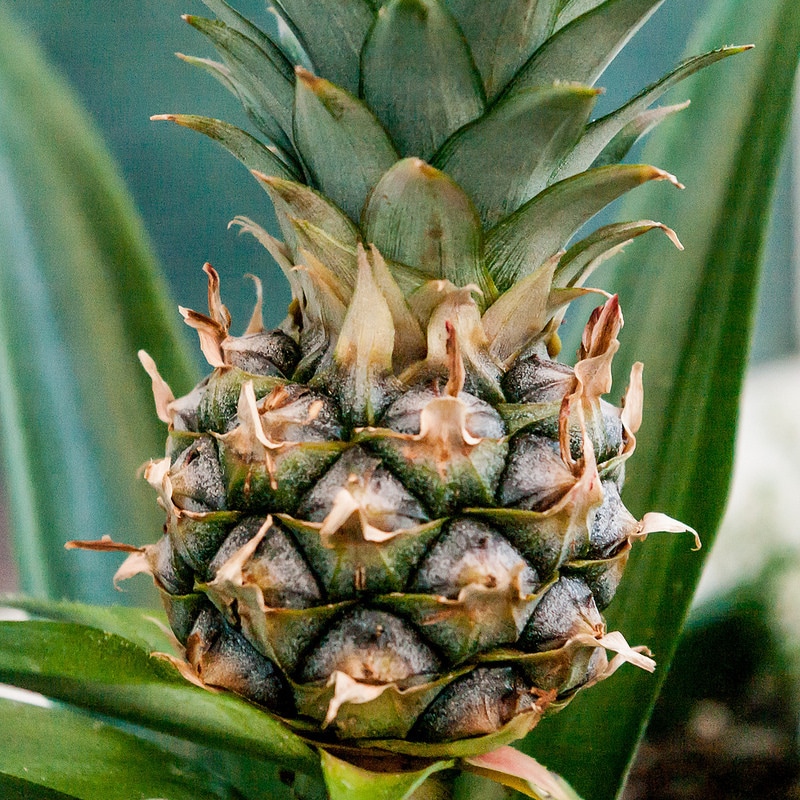|
Bromeliads entered recorded history some 500 years ago when Columbus introduced the pineapple (Ananas comosus) to Spain upon return from his second voyage to the New World in 1493. On that voyage he found it being cultivated by the Carib Indians in the West Indies. Within 50 years this tropical fruit was being cultivated in India and other Old World countries. It took some time for additional bromeliads to enter cultivation. It wasn't until 1776 that another bromeliad (Guzmania lingulata) was brought to Europe. Aechmea fasciata followed in 1828 and Vriesea splendens in 1840. Within the last hundred years, bromeliads have become more widely used as ornamental plants. Originally only found in royal botanical gardens or the private greenhouses of wealthy Europeans, their popularity has spread to the masses. Today bromeliads are more available to the enthusiast than ever before. New species are still being discovered and plant breeders are developing ever more stunning hybrids to choose from. Click HERE to view a terrific article on the symbolism of the pineapple.
Comments are closed.
|
AuthorSome articles courtesy of Bromeliad Society International – adapted for the San Diego region ArchivesCategories
All
|
- Home
- Join us! Membership
-
Meetings/Events
- Past: July 2024
- Past: May in the Garden
- Past: April 2024
- Past: February 2024
- Past: January 2024
- Past: December 2023
- Past: Nov. 2023
- Past: Oct. 2023
- Past: Sept. 2023
- Past: July 2023
- Past: May Tour
- Past: June 10-11 Show & Sale
- Past: April 2023
- Past: March 2023
- Past: February 2023
- Past: January 2023
- Past: Oct. 2022
- Past: Sept. 2022
- June Show & Sale Balboa Park
- Past: May 2022
- World Brom Conference 2022
- Past: April 2022
- Past: March 2022
- Past: Feb 2022
- Past: Dec. 2021 Plant Sale
- Past: Dec 2021
- Past: Nov 2021
- Past: Expo at SD Botanic Garden
- Past: August 2021
- Past: July 2021
- Past June 2021
- Past: May 2021
- Past: April '21
- past: March '21
- past: February '21
- past: January '21
- Past: December
- Past: October
- Past: September
- Past: November
- August Coffee in the Brom Garden
- Past Newsletters
- Videos
- About Us/Past Events
- Bromeliad Genera
- Links
- Growing Tips
Photo from STC4blues
- Home
- Join us! Membership
-
Meetings/Events
- Past: July 2024
- Past: May in the Garden
- Past: April 2024
- Past: February 2024
- Past: January 2024
- Past: December 2023
- Past: Nov. 2023
- Past: Oct. 2023
- Past: Sept. 2023
- Past: July 2023
- Past: May Tour
- Past: June 10-11 Show & Sale
- Past: April 2023
- Past: March 2023
- Past: February 2023
- Past: January 2023
- Past: Oct. 2022
- Past: Sept. 2022
- June Show & Sale Balboa Park
- Past: May 2022
- World Brom Conference 2022
- Past: April 2022
- Past: March 2022
- Past: Feb 2022
- Past: Dec. 2021 Plant Sale
- Past: Dec 2021
- Past: Nov 2021
- Past: Expo at SD Botanic Garden
- Past: August 2021
- Past: July 2021
- Past June 2021
- Past: May 2021
- Past: April '21
- past: March '21
- past: February '21
- past: January '21
- Past: December
- Past: October
- Past: September
- Past: November
- August Coffee in the Brom Garden
- Past Newsletters
- Videos
- About Us/Past Events
- Bromeliad Genera
- Links
- Growing Tips

